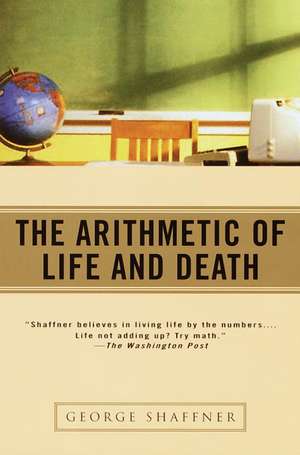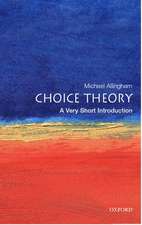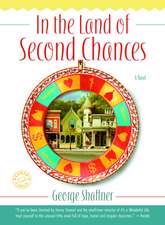The Arithmetic of Life and Death
Autor George Shaffneren Limba Engleză Paperback – 30 apr 2001
Illuminated with anecdotes, humor, and insight, each chapter explains a unique part of life that can be understood only through the magic of numbers. Whether it's an unconventional theory on why more things go wrong than right, a simple calculation of how much it will cost you to smoke for a lifetime, why crime (accumulatively) doesn't pay, or a glimpse into the probability of life after death, this enlightening and lucidly reasoned book will forever change the way you think about numbers--and the world around you.
Preț: 88.88 lei
Nou
Puncte Express: 133
Preț estimativ în valută:
17.01€ • 17.57$ • 14.16£
17.01€ • 17.57$ • 14.16£
Carte disponibilă
Livrare economică 05-19 martie
Preluare comenzi: 021 569.72.76
Specificații
ISBN-13: 9780345426451
ISBN-10: 0345426452
Pagini: 220
Dimensiuni: 140 x 217 x 14 mm
Greutate: 0.29 kg
Ediția:Trade Pbk.
Editura: BALLANTINE BOOKS
Locul publicării:United States
ISBN-10: 0345426452
Pagini: 220
Dimensiuni: 140 x 217 x 14 mm
Greutate: 0.29 kg
Ediția:Trade Pbk.
Editura: BALLANTINE BOOKS
Locul publicării:United States
Extras
CHAPTER
1
The Probability That
You Would Be You
"What is the odds so long as the fire
of soul is kindled . . ."
--CHARLES DICKENS
Since some six billion people now occupy planet Earth, one could conclude
that human life is as common as dirt in Denmark. There is, however, some
evidence to the contrary. Gwendolyn Sharpe, anthropology student, and
daughter of a prominent Northwestern personality, is a good example.
Like every human being, Gwendolyn is a construction
of forty-six chromosomes. Twenty-three came from her mother, Cecilia, and
the other twenty-three came from her estranged father. Each of her parents
had forty-six chromosomes from which to choose, nicely organized in
twenty-three pairs. Through the miracle of natural selection, either one
of each chromosome pair from each of her parents could have been chosen
for production. The resulting twenty-three chromosomes from each parent
were then paired to make Gwendolyn's forty-six.
The odds that Gwen would get the exact twenty-three chromosomes that she
received from her mother were one-half times one-half times one-half times
one-half, a total of twenty-three times, or .5 to the twenty-third power.
That means that the probability that Cecilia would give Gwendolyn the
twenty-three chromosomes she got was about one in ten million
(10,000,000), which was less likely than winning the state lottery (about
one in seven million in Washington, although the odds are longer in some
states).
The odds that Gwen would get the twenty-three chromosomes she got from her
father were also about one
in ten million. So, the probability that Gwendolyn would be Gwendolyn was
about one in 100 trillion (one in 100,000,000,000,000). On any given day,
a win in the Washington state lottery would be around fourteen million
times more likely than a Gwendolyn Sharpe.
But that assumes the existence, union, and productive sex lives of Gwen's
mother and father. Gwendolyn's parents met at a small Pacific Northwest
university with a student population of 1,000 men and 1,000 women. Like so
many young women back then, Gwen's mother hoped to meet and marry the man
of her dreams before leaving college with a degree in accounting. Like so
many young men back then, Gwendolyn's father planned to practice a few
of the more physical rituals of marriage throughout the
six years it would take him to obtain an undergraduate de-
gree in political science. Correctly assuming, however, that Gwendolyn's
mother would inevitably prevail, the maximum probability of the productive
union of her parents was a one-in-a-thousand long shot, which lengthened
the odds of Gwendolyn's existence to about one in 100 quadrillion (1 in
100,000,000,000,000,000).
However, the odds of Gwendolyn's mother's being her mother were at least
one in 100 quadrillion, too. The probability that her father would be her
father was the same. So the odds of Gwendolyn's being Gwendolyn were
closer to one in 1,000,000,000,000,000,000,000,000,
000,000,000,000,000,000,000,000,000. But that figure excludes
consideration that either parent might have been infertile, that either
might have been killed before conception, or that they might have divorced
before the moment of magic that produced Gwendolyn or any of her brothers.
Nor has there been any inclusion of the extreme unlikelihood of the
existence of Cecilia's parents, who were from Yakima and Chewelah, or her
husband's parents, or their parents, or their parents, ad infinitum.
Netting all of this down to scientific terms, the odds that Gwendolyn
would be Gwendolyn were less than one in a jillion gazillion. The same is
true for each of us. Against such long odds, every life is a miracle of
immeasurable
proportion, courtesy of nature. Thus, the existence of so many billions of
people is not evidence of the commonness of life but a testament to the
infinite scale of nature's benevolence.
Acceptance of such an improbable gift is not without obligation. An annual
donation to the National Wildlife Fund is sweet, but the gift of life
requires payment in kind. In order to fairly compensate nature for her
generosity, each of us must help others to enjoy the gift, we must never
harm or take the gift from another, and we must each live our own life to
its fullest extent, despite the inevitable bumps in the road.
1
The Probability That
You Would Be You
"What is the odds so long as the fire
of soul is kindled . . ."
--CHARLES DICKENS
Since some six billion people now occupy planet Earth, one could conclude
that human life is as common as dirt in Denmark. There is, however, some
evidence to the contrary. Gwendolyn Sharpe, anthropology student, and
daughter of a prominent Northwestern personality, is a good example.
Like every human being, Gwendolyn is a construction
of forty-six chromosomes. Twenty-three came from her mother, Cecilia, and
the other twenty-three came from her estranged father. Each of her parents
had forty-six chromosomes from which to choose, nicely organized in
twenty-three pairs. Through the miracle of natural selection, either one
of each chromosome pair from each of her parents could have been chosen
for production. The resulting twenty-three chromosomes from each parent
were then paired to make Gwendolyn's forty-six.
The odds that Gwen would get the exact twenty-three chromosomes that she
received from her mother were one-half times one-half times one-half times
one-half, a total of twenty-three times, or .5 to the twenty-third power.
That means that the probability that Cecilia would give Gwendolyn the
twenty-three chromosomes she got was about one in ten million
(10,000,000), which was less likely than winning the state lottery (about
one in seven million in Washington, although the odds are longer in some
states).
The odds that Gwen would get the twenty-three chromosomes she got from her
father were also about one
in ten million. So, the probability that Gwendolyn would be Gwendolyn was
about one in 100 trillion (one in 100,000,000,000,000). On any given day,
a win in the Washington state lottery would be around fourteen million
times more likely than a Gwendolyn Sharpe.
But that assumes the existence, union, and productive sex lives of Gwen's
mother and father. Gwendolyn's parents met at a small Pacific Northwest
university with a student population of 1,000 men and 1,000 women. Like so
many young women back then, Gwen's mother hoped to meet and marry the man
of her dreams before leaving college with a degree in accounting. Like so
many young men back then, Gwendolyn's father planned to practice a few
of the more physical rituals of marriage throughout the
six years it would take him to obtain an undergraduate de-
gree in political science. Correctly assuming, however, that Gwendolyn's
mother would inevitably prevail, the maximum probability of the productive
union of her parents was a one-in-a-thousand long shot, which lengthened
the odds of Gwendolyn's existence to about one in 100 quadrillion (1 in
100,000,000,000,000,000).
However, the odds of Gwendolyn's mother's being her mother were at least
one in 100 quadrillion, too. The probability that her father would be her
father was the same. So the odds of Gwendolyn's being Gwendolyn were
closer to one in 1,000,000,000,000,000,000,000,000,
000,000,000,000,000,000,000,000,000. But that figure excludes
consideration that either parent might have been infertile, that either
might have been killed before conception, or that they might have divorced
before the moment of magic that produced Gwendolyn or any of her brothers.
Nor has there been any inclusion of the extreme unlikelihood of the
existence of Cecilia's parents, who were from Yakima and Chewelah, or her
husband's parents, or their parents, or their parents, ad infinitum.
Netting all of this down to scientific terms, the odds that Gwendolyn
would be Gwendolyn were less than one in a jillion gazillion. The same is
true for each of us. Against such long odds, every life is a miracle of
immeasurable
proportion, courtesy of nature. Thus, the existence of so many billions of
people is not evidence of the commonness of life but a testament to the
infinite scale of nature's benevolence.
Acceptance of such an improbable gift is not without obligation. An annual
donation to the National Wildlife Fund is sweet, but the gift of life
requires payment in kind. In order to fairly compensate nature for her
generosity, each of us must help others to enjoy the gift, we must never
harm or take the gift from another, and we must each live our own life to
its fullest extent, despite the inevitable bumps in the road.
Recenzii
"AN APPEALING MIX OF COMMON SENSE AND SOLID REASONING . . . Written in lively style, with sly wit . . . Shines light into several interesting corners of everyday life, often with surprising results--and the numbers don't lie."
--Kirkus Reviews
"Shaffner's writing is . . . clever and clear. . . . It's highly probable that many readers will learn from it."
--Publishers Weekly
--Kirkus Reviews
"Shaffner's writing is . . . clever and clear. . . . It's highly probable that many readers will learn from it."
--Publishers Weekly
Descriere
Maverick computer executive George Shaffner answers life's most perplexing questions in this book. His new life philosophy offers no complex equations or proofs. Whether readers are contemplating the risks of smoking, the advantages of teamwork, the miracle of birth, or the mysteries of middle management, Shaffner's insightful and unconventional wisdom will forever change the way readers think about life.
Notă biografică
George Shaffner has worked in the computer industry for twenty years, most recently as CEO or COO of three international computer companies. He is the father of three children, who are all math refugees.













